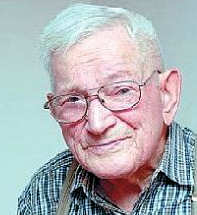Heavy Weapons Company - 4th Infantry Division

Coming home one day after work [at a shipyard], I had a piece of mail that all men of my age dreaded to receive (a draft notice). This came as a shock and complete disruption to myself and family as I had to quit jobs, make much preparation for my wife and children, and say “good-bye” to neighbors.
Those selected by the draft went through processing at Fort Dix, N.J. We were all sent to an infantry training camp in South Carolina. I didn’t even know what an infantry man was, but after a day at Camp Croft and indoctrination, I got the message real quick.
We endured 17 weeks of rigorous physical and mental training. Then we were sent home on a 14day furlough. Later we loaded on a troop ship in New York Harbor. The ship was the Ile de France, a French passenger liner with a British crew. It was an uneventful ocean crossing to a port in Scotland.
Then we traveled by train to Liverpool, where a somber sight greeted us. You could see the damage from German air raids; there were shrapnel pock marks on the buildings and walls.
A troop ship transported us to Le Havre, France, where we arrived at daybreak. We unloaded into smaller landing craft and headed for shore and loaded onto trucks. We later headed into the interior of France, to Givet, where we were issued new M1 Garand rifles.

M1 Garand Rifle
Soon we traveled many miles from Givet to Aachen, Germany, which our forces had recently taken with heavy fighting. Finally after weeks of training and travel, we went into combat during the Hurtgen Forest Campaign, which was an epic of stark infantry combat.
We slogged through the forest roads that were churned into mud. Wherever we went, it was mud, mud, mud, thick, gooey mud! At times we even slept in it.
As we entered the forest, we watched a large Army drive out, loaded with dead soldiers. This was bad for our morale, which was already very low.
I dug foxholes all over Europe. Every time we got pinned down by enemy fire, I would dig a low spot to get into. We would put logs over our foxholes and cower under them during an artillery bombardment.
We were constantly bombarded with the Germans’ most effective artillery, the 88 mm. cannons.
Tree bursts were our biggest problem. Most of our casualties came from these 88s, because when a shell hit the top of a tree, it would explode and send shrapnel downward.
The Hurtgen Forest Campaign was all forest fighting. It was like deer hunting where you would go cautiously through the woods looking for men who also had guns. It was a question of who got whom first.
I participated in weeks of heavy fighting. There would be much firing of machine guns, rifles, and sometime grenades. Once on a patrol we got lost, but come evening, we felt at ease as we were in front of our artillery a short distance away.
We spotted two German soldiers out in front of the artillery, and that night and for the next two days, all hell broke loose; we were actually in front of German artillery! Billy Picket (our medic) and I lay in a slit trench a whole day and night while they shelled us.
Saying “hello, hello,” a German soldier came into our position one night. Sergeant Peters challenged the German, who shot him through the cheek bone and jaw with a pistol. The bullet traveled through his lung. I helped four other men carry Peters up the side of a steep hill to a jeep equipped to transport wounded men. It was sickening to watch him trying to breathe as bloody foam came out of his mouth every time he exhaled!
Later, as we withdrew after dark, a tank shell whistled by my face so close that I could smell the powder. A soldier ahead of the soldier in front of me stepped on a shoe mine, which exploded and blew his foot off.
The Hurtgen Forest was roughly 50 square miles. Nine divisions of our troops fought an equal or greater amount of German troops.
Our division, the 4th Infantry, came in later, fought for 26 days, and lost 7,000 men. The entire battle lasted 90 days at the cost of 24,000 American casualties.

~~~Frank Slegona~~~
May 25, 1918 - † March 3, 2011

Source: Bangor Daily News
